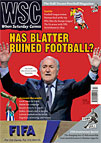 Steve Anders recalls Manchester United’s only season in the last 75 years in the second tier of English football, which proved to be a year remembered for hooliganism
Steve Anders recalls Manchester United’s only season in the last 75 years in the second tier of English football, which proved to be a year remembered for hooliganism
The long-term significance
Hooliganism was becoming a major social problem. In the first significant trouble involving the English abroad, Spurs fans had rioted at the second leg of the UEFA Cup final in Rotterdam in May 1974. Three months later, a Blackpool fan was stabbed to death during a Division Two match against Bolton at Bloomfield Road.
Within a few days of that incident, sports minister Denis Howell announced that he was considering a range of new measures including longer jail sentences for football-related violence and compulsory ID cards for fans. At the end of this season, Leeds were banned from Europe for four seasons, later cut to two, after their fans confronted riot police at the European Cup final in Paris.
On the pitch, Man Utd experienced their only season at the second level in the last 75 years – a circumstance they have not come close to repeating since. At the other end of the table, Sheffield Wednesday, who had been League members since 1892-93, dropped into Division Three for the first time.
Story of the season
Man Utd led from the start, losing only one of their first 16 games – 2-0 at Norwich in late September. Tommy Docherty’s side only wobbled briefly in February when a run of three defeats in four matches brought the chasing pack to within a few points. United were captained by Scottish centre-back Martin Buchan, whose compatriot Lou Macari formed a strike partnership with Stuart Pearson; Sammy McIlroy and Gerry Daly were key figures in midfield. Goalkeeper Alex Stepney was the only survivor from the squad that had won the European Cup seven seasons before.
Still fielding most of the side that won the FA Cup in 1973, Sunderland were erratic in front of goal and eight 0-0 draws proved to be their undoing. They were in the promotion positions from the start of October until their last match, which they lost 2-0 at Aston Villa. John Bond’s Norwich – who had gone down with Man Utd – clinched third place with a 3-0 win at Portsmouth on the same day. Villa returned to Division One after an eight-year absence with a run of 12 wins in their last 14 games. They also won the League Cup, beating Norwich 1-0 in the final.
Sheffield Wednesday took part in one of the games of the season, a 4-4 home draw with Man Utd in December, but they were to only score one league goal in the first three months of 1975 and went down with several weeks to spare. The 7,444 who saw Wednesday’s penultimate home game against Oxford was the lowest League crowd in their history. Cardiff sealed their fate by taking only one point from their last six games. Millwall could have stayed up by winning at home to Bristol Rovers in their final match but drew 1-1.
For the record books
Brian Little of Aston Villa was the division’s top scorer with 20 goals, one ahead of team-mate Ray Graydon, Mick Channon of Southampton and Sunderland’s Bryan Robson.
With an average crowd of 48,389, Man Utd were the best supported team in the entire League. Notts County become the first club to play 3,000 League games, the match in question being a 2-2 draw at home to neighbours Forest.
Same place today
Eight of these clubs will be in the Championship in 2011-12 of which Cardiff City are the only ones not have played at the top level since this season.
Moved furthest away
York City, who were playing their first ever season in Division Two, are now in the Blue Square Premier where Oxford Utd have also spent time recently. Nine other clubs played at the fourth level subsequently, although only Bristol Rovers will be there next season.
From WSC 293 July 2011